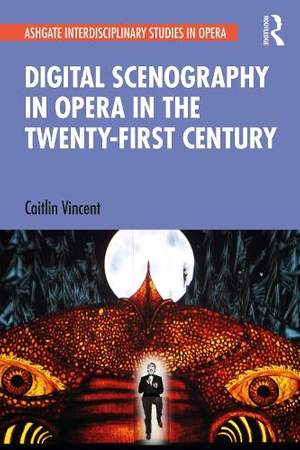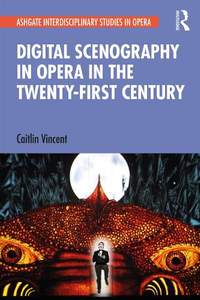
Digital Scenography in Opera in the Twenty-First Century
- Author: Vincent, Caitlin
Book
$182.75Printed on demand
Contents
- Introduction Chapter One - Digitally-enhanced opera in the twenty-first century and the modes of synthesis Chapter Two - Digitally-enhanced opera in the twenty-first century and the variants of causal interplay Chapter Three - The lineage of digital sceno
- Introduction to digital scenography in opera
- What is digital scenography?
- Why opera?
- Research methods
- The modes of synthesis
- Examples of practice
- Interviews
- Chapter outline
- References
- Chapter One - A new classification system for digital scenography: the modes of synthesis
- Articulating the modes of synthesis: non-synthesis, partial-synthesis, and full- synthesis
- Non-synthesis-San Francisco Opera, The Magic Flute (2012)
- Partial-synthesis-Theatre Royal de la Monnaie, The Magic Flute (2005)
- Full-synthesis-Komische Oper Berlin, The Magic Flute (2012)
- A comparison of critical responses to the three productions
- Conclusion
- References
- Chapter Two - The variants of causal interplay
- Agency: the screen as 'performer'
- Dutch National Opera, The Magic Flute (2012)-partial-synthesis
- Victorian Opera, Four Saints in Three Acts (2016)-partial-synthesis
- Augmentation: extension and transformation through digitalisation
- The Royal Opera, Covent Garden, Don Giovanni (2014)-partial-synthesis
- Victorian Opera, The Flying Dutchman (2015)-partial-synthesis
- Full-synthesis extremes of agency and augmentation
- Opera de Lyon, L'Enfant et les Sortileges (2016)-full-synthesis
- Autonomy: faux-interactivity versus functional interactivity
- The Metropolitan Opera, Das Rheingold (2010)-partial-synthesis
- Implications for performers and audiences
- References
- Chapter Three - The lineage of digital scenography in opera: Baroque origins to the twentieth century
- The origins of the Baroque opera paradigm
- The Baroque paradigm and the interplay between performer, stage setting, and spectator
- New perspectives: the scenic reforms of Ferdinando Galli-Bibiena (1657-1743)
- The scenographic transition to 'grand opera'
- The 'mystic chasm': Richard Wagner (1813-1883) and the Bayreuth Festspielhaus
- Adolphe Appia (1862-1928) and dynamic light
- Looking towards the twentieth century
- References
- Chapter Four - The lineage of digital scenography in opera: multimedia developments in the twentieth century
- Avant-garde origins
- Edward Gordon Craig (1872-1966) and Enrico Prampolini (1894-1956): 'a thousand scenes in one' and 'luminous forms'
- Josef Svoboda (1920-2002) and the dynamic setting of the Laterna Magika
- The Tales of Hoffmann (1962)
- Gunther Schneider-Siemssen (1926-2015) and the holograms of the Salzburg Marionette Theatre
- The Tales of Hoffmann (1985)
- Looking towards the twenty-first century
- References
- Chapter Five - The projection designer and evolving creative hierarchies
- Industry recognition and acknowledgement
- The traditional theatrical hierarchy: director as ultimate authority
- The lateral hierarchy: collective directorate
- Hierarchical variation: projection designers as the directorial authority
- The evolving role of the projection designer
- References
- Chapter Six - Digital scenography and evolving production design processes
- A benchmark of organisational and funding models
- The twentieth-century standard for production design
- Washington National Opera's Das Rheingold (2016)-non-synthesis
- Theatre Royal de la Monnaie's The Magic Flute (2005)-partial-synthesis
- Dutch National Opera's The Magic Flute (2012)-partial-synthesis
- Santa Fe Opera's The (R)evolution of Steve Jobs (2017)-non-synthesis
- Komische Oper Berlin's The Magic Flute (2012)-full-synthesis
- Commonalities across the five production design processes
- Production design processes and the modes of synthesis
- References
- Conclusion - The future evolution of digital scenography
- References
- Appendix 1
- Appendix 2
- Appendix 3



